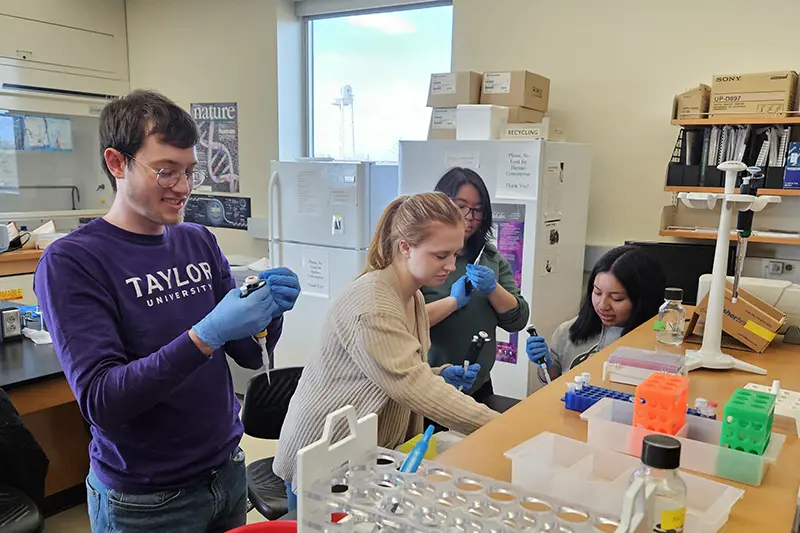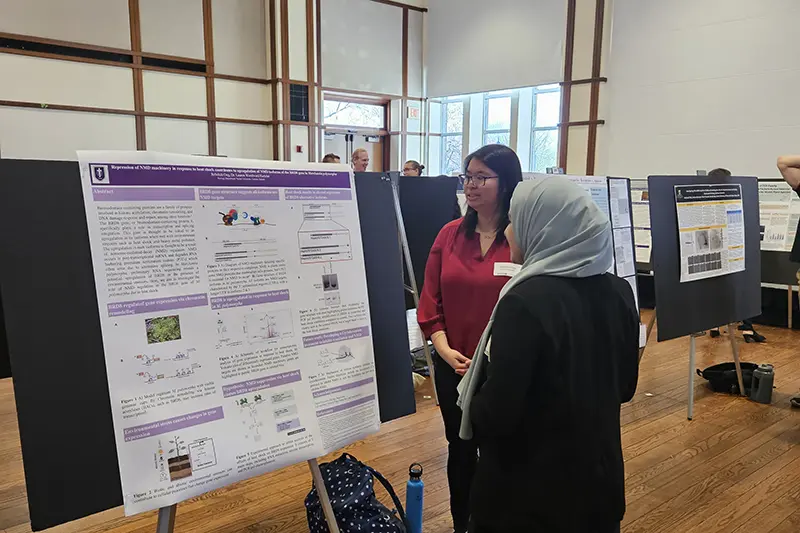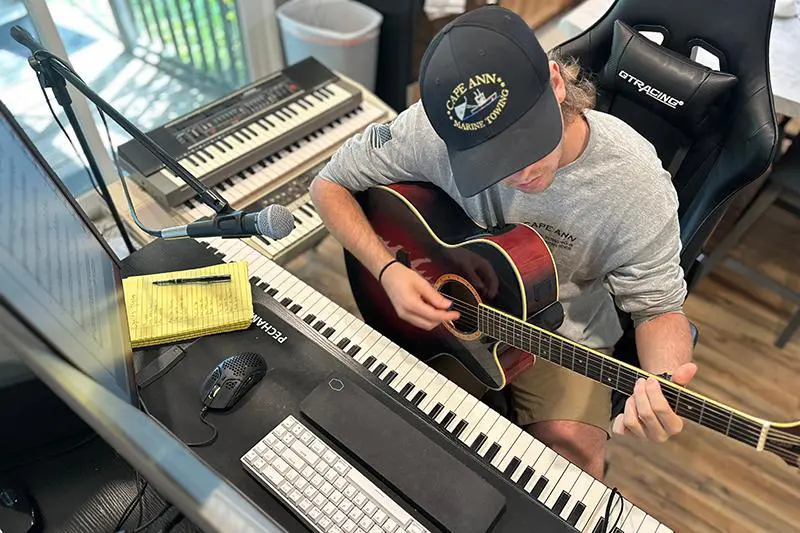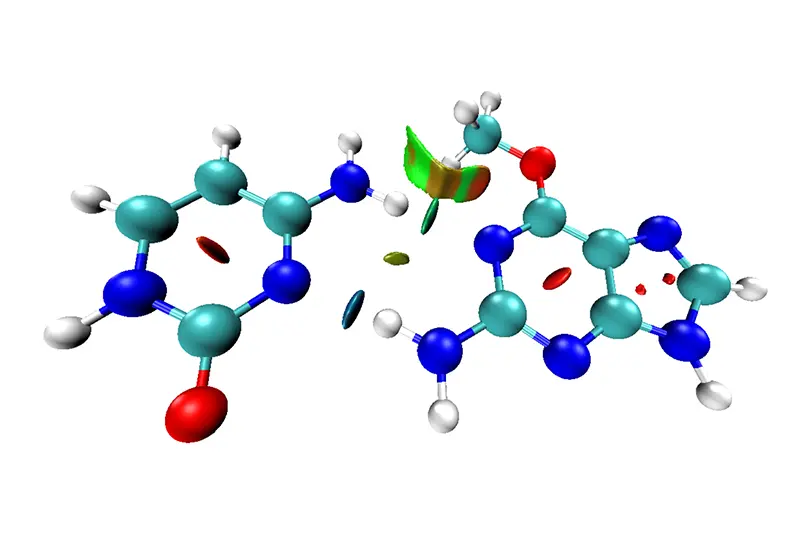-
-
- Financial Aid
- Financial Aid
- Scholarships
- Loans
- Grants
- Federal Work Study
- Additional Resources
-

Most classes may have been out for the summer, but faculty-mentored research projects were in full swing across campus.
Studies show that undergraduate students who participate in research projects have better grades, are more prepared for study or career after graduation, and have more clarity in their future goals. Here are just a few snapshots of some of the research work students and faculty were exploring over the summer at Taylor University.
Taylor’s growing Engineering program was bustling over the summer with students working on several research projects.
Water filtration project: Senior David Mitchell continued to design and make improvements to a water filtration system for a hospital in Bangladesh. He spent the summer improving filtration quality and system reliability as well as reducing system manufacturing costs.
Building in Space: Juniors Koby Rodgers and Harrison Schmitt worked on the SkyForge project. This project, funded by the Indiana Space Grant Consortium, is developing a first-generation lab version of a robot designed to build expansive space structures in Earth’s orbit. Over the summer, the students did preliminary research on the space environment, developed a test architecture meant to improve the robot’s ability to withstand space radiation, and designed a small form factor arm joint for operating in the vacuum and cold of space. This research will continue in the spring of 2024.
Other projects: Addison Johnson ‘23, who is now attending the robotics graduate program at Oregon State University, worked on refining and controlling the Next Generation Sulfur Concrete Print Head. The print head is a prototype for 3D printing structures on Mars.
The Women’s Giving Circle made it possible for John Pugsley ‘22, who now works for Near Space Launch in Upland, to continue to work on the New Worlds virtual reality walking interface. John is making improvements to allow further testing of the system that had been his senior project.
“We are thankful for the funding we’ve received that is allowing us to push forward with these projects,” said Dr. Peter Staritz, Associate Professor of Physics and Engineering. “Our students are working with cutting-edge ideas, doing incredible work, and making real contributions to the engineering world.”
Professor of Biology Lauren Woodward Hartzler led a plant genetics research effort to learn more about how regulation of mRNA stability helps plants respond to heat stress and heavy metal pollution in their environment.
“All organisms and plants are able to respond to their environment by changing gene expression. One way that gene expression can be changed is by tinkering with the stability of mRNA molecules,” said Woodward.
“If we can identify the genes or biological pathways that are regulated during these responses, there is a potential to harness that information to generate plants that are more resilient to surviving in climates and conditions that other plants would likely perish in. There is even the potential that such plants could be used to remediate disturbed or polluted areas.”

Hartzler and student Rebekah Ong made significant progress toward making a genetically modified plant that will be less capable of degrading some mRNAs. This project was primarily funded by the Women’s Giving Circle.
Dr. Reed Spencer, professor of Music, and Musical Theatre major Steven Day have been working collaboratively on lyrics, music, recording, and notation for a musical theatre composition project that addresses Generation Z’s experiences with social media.
“We took on this project with the goal of approaching this with a desire to acknowledge social media’s important place in our society, while exploring the complex problems and emotions that accompany its use,” said Spencer.
Over the course of the summer, Spencer and Day wrote eleven songs, recorded them, and began the process of notation. They plan to workshop the music, eventually produce a production of their work with more Taylor students, with the hope to submit it to competitions and find external performances.

Professor of Chemistry Dr. Michael Bowman and student Kirsten Stinson used methods in computational chemistry to understand how certain gene mutations can lead to cancer. They have been studying O6-methylated guanine and thioguanine complexes, which are molecules of a mutated form of guanine, one of the fundamental building blocks of DNA known as nucleobases.
“Previous studies have demonstrated a connection between these mutated nucleobases and certain types of cancers, which is surprising given the relatively minor change to the natural guanine structure,” said Bowman. “By examining the interactions between O6-methylguanine or thioguanine with other nucleobases, we hope to help others understand how such mutations lead to cancer.”
They made significant progress in yielding results that affirm their hypothesis, and they plan to do additional research using computational methods with a higher level of accuracy as well as other forms of analysis to provide a more comprehensive picture of these systems.

Dr. Daniel Kaluka, professor of Biochemistry, led four students on two different projects.
Malaria parasite: Malaria is an infectious and deadly disease caused by the parasite Plasmodium Falciparum. Although drugs have been developed to fight against this disease, reports of increased drug resistance call for the need to design new intervention strategies. Kaluka has been researching how hemeproteins within the parasite’s genome can lead to identification of new therapeutic targets in the mosquito stage of the parasite. Anna Draviam and Gabriel Swinney worked on furthering his research over the summer.
“Malaria remains a public health problem, especially in the developing world. For children under age 5, it’s reported especially high mortality rates,” said Kaluka. “Understanding the malaria parasite biochemistry is a step towards developing new intervention strategies. Our goal is to use our understanding of protein structure-function relationship to unveil the parasite's vulnerabilities and thus stop the transmission of malaria.”
Investigating the Sequence-Structure-Function Relationship of beta-glucosidase B (enzyme): Kaluka and students Annika Bennett and Carter Ahlstedt were part of a design-to-data network of scholars initiated by Professor Steven Seigel of University of California Davis. Seigel’s lab provided most of the research materials needed.
Bennett and Ahlstedt used computational tools to design mutants of b-glucosidase B and perform functional studies on their novel enzymes using biochemistry techniques, which are employed routinely in the biotechnology world. This student-generated data will be utilized in training protein modeling algorithms, such as the Rosetta Commons, which presently have less than optimal predictive capabilities due to a small number of data sets.
“Understanding and manipulating protein structure and function is important in protein engineering (for example, enzyme designed to metabolize plastic waste) and human health research (for example, drug design),” said Kaluka. “The biggest challenge in protein engineering is designing proteins that are both thermally stable and catalytically efficient. That’s why computational design of such proteins is a welcome advancement.”
Research projects don’t have to wait until grad school or beyond. At Taylor, students have access to undertaking major projects in a broad range of interest areas and faculty who are willing to mentor and guide the process. Want to learn more? Request more information about Taylor University today.